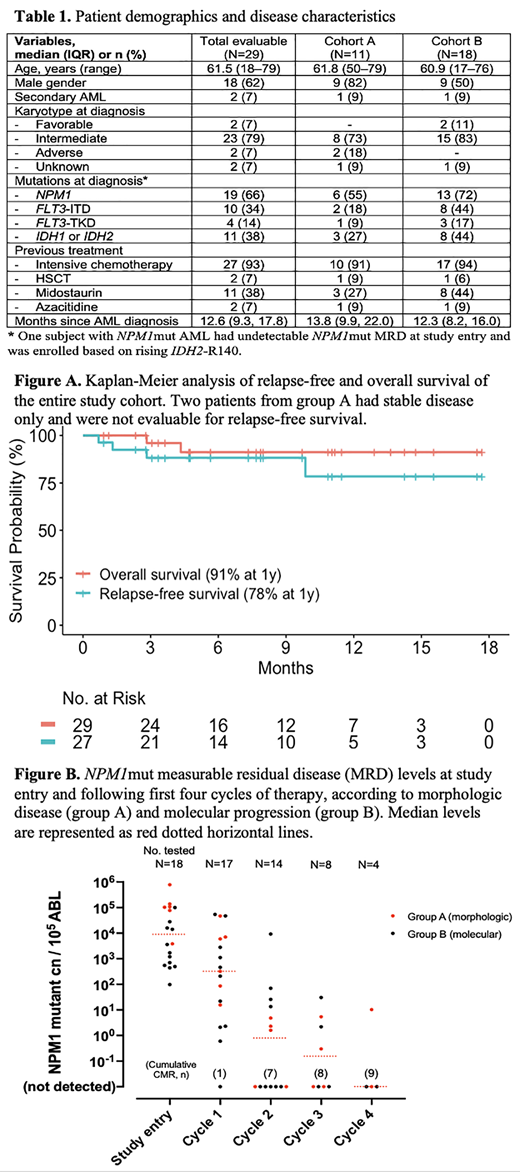Abstract
Introduction
Rising molecular measurable residual disease (MRD) is an arbiter of clinical relapse in acute myeloid leukemia (AML). Venetoclax (VEN) is active against IDH and NPM1 mutant (mt) AML as monotherapy (Konopleva et al, 2016 and Chua et al, 2020) and can yield MRD negative remission when combined with low dose ara-C (LDAC) in patients unfit for intensive chemotherapy (DiNardo and Tiong et al, 2020). In a retrospective study, we showed that VEN in combination with hypomethylating agents or LDAC could erase rising NPM1mt MRD in 6/7 cases (Tiong et al, 2020). We now present a prospective phase 2 study of VEN and LDAC in patients with molecular MRD failure or oligoblastic AML relapse.
Methods
This multicenter phase 2 study stratified patients into oligoblastic relapse (marrow blasts 5-15%; Group A), or molecular MRD failure (Group B) as defined by the European LeukemiaNet (ELN) recommendations (failure confirmed by 2 interval samples) (Schuurhuis et al, 2018). Patients received VEN 600 mg (days 1-28) and LDAC 20 mg/m 2 (days 1-10). Primary objectives were morphologic or MRD response (≥1 log reduction) in groups A and B, respectively. Key secondary objectives were allogeneic hematopoietic cell transplantation (allo-HCT) realization and relapse-free (RFS) and overall survival (OS). The study had Alfred Health ethics approval (196/19). NPM1mt and other fusion transcript levels (per 10 5 ABL) from bone marrow were analyzed by RT-qPCR, IDH1 and IDH2 by Bio-Rad TM droplet digital PCR.
Results
The study enrolled 32 patients, with 29 evaluable (cut-off date 15/7/21). The median age of the study population was 62 years; 79% had intermediate cytogenetic risk, 66% NPM1mt, 11% FLT3-ITD and 37% IDH1/IDH2 mt. Most received prior intensive chemotherapy (93%) and 2 (7%) allo-HCT in first remission. Median interval from AML diagnosis to study entry was 12.6 months (Table 1). After a median follow-up of 7.9 months, patients had received a median of 3 cycles (range 1-14) of VEN-LDAC, with 13 patients ongoing. The main reasons for treatment cessation were allo-HCT (n=10; 34%) or donor lymphocyte infusion (n=2; 7%), treatment failure (n=3) or an adverse event (n=1). Hematologic complete/incomplete response (CR/CRi) among 11 patients with oligoblastic relapse (group A) was 73% and included: CR (n=5, 45%) or CRi (n=3, 27%), with an additional patient with morphologic leukemia-free state and 2 patients with stable disease. Overall, across both groups, median RFS and OS were not reached, estimated at 78% and 91% at 1 year, respectively. Among 18 patients with molecular MRD failure (group B) treated with VEN+LDAC, molecular response (≥1 log reduction) was achieved in 72%, and the RFS and OS were estimated at 83% and 87% at 1 year, respectively.
Analysis of a sub-group of patients with NPM1mt (n=18); 6 and 12 from Groups A and B, respectively revealed the median NPM1mt transcript level at study entry to be 8985 copies (IQR 826, 94,431). A molecular response was achieved in 14 (78%) patients, including 9 (50%) with complete molecular remission (CR MRD-), with most responses achieved within 2 cycles of therapy (Figure B).
Treatment with VEN-LDAC was generally well tolerated, with 15 serious adverse events reported within the first 2 cycles, including infection (n=6; 19%) and febrile neutropenia (n=3; 9%). Only one subject discontinued treatment due to stroke.
Conclusions
In this prospective study, in patients with first oligoblastic relapse or MRD failure, VEN in combination with LDAC induced a high rate of molecular MRD remission that was rapidly achieved, resulting in a high rate of survival at 12-months (>90%) and with low toxicity. Follow-up is ongoing to determine the durability of response. Treatment of patients with MRD or early clinical failure may represent an attractive clinical trial setting for investigation of novel, non-intensive AML therapies. This approach will be investigated in a future multi-arm, precision-based platform trial called INTERCEPT (Investigating Novel Therapy to Target Early Relapse and Clonal Evolution as Pre-emptive Therapy in AML).
Tiong: Servier: Consultancy, Speakers Bureau; Amgen: Speakers Bureau; Pfizer: Consultancy. Hiwase: Novartis: Membership on an entity's Board of Directors or advisory committees; AbbVie: Membership on an entity's Board of Directors or advisory committees. Fleming: Amgen Inc: Research Funding. Bajel: Amgen: Speakers Bureau; Abbvie, Amgen, Novartis, Pfizer: Honoraria. Fong: Amgen, BMS: Speakers Bureau; Amgen: Research Funding; AbbVie, Amgen, Novartis, Pfizer, Astellas: Honoraria. Wei: Celgene/BMS: Membership on an entity's Board of Directors or advisory committees, Research Funding, Speakers Bureau; Agios: Membership on an entity's Board of Directors or advisory committees; Novartis: Membership on an entity's Board of Directors or advisory committees, Research Funding, Speakers Bureau; Genentech: Membership on an entity's Board of Directors or advisory committees; Abbvie: Membership on an entity's Board of Directors or advisory committees, Research Funding, Speakers Bureau; Astellas: Membership on an entity's Board of Directors or advisory committees; Gilead: Membership on an entity's Board of Directors or advisory committees; Astra Zeneca: Membership on an entity's Board of Directors or advisory committees, Research Funding; Amgen: Membership on an entity's Board of Directors or advisory committees, Research Funding; Roche: Membership on an entity's Board of Directors or advisory committees; Pfizer: Membership on an entity's Board of Directors or advisory committees; Janssen: Membership on an entity's Board of Directors or advisory committees; Macrogenics: Membership on an entity's Board of Directors or advisory committees; Servier: Membership on an entity's Board of Directors or advisory committees, Research Funding.
This presentation will discuss the use of venetoclax in targeting measurable residual disease and early relapse of acute myeloid leukemia.


